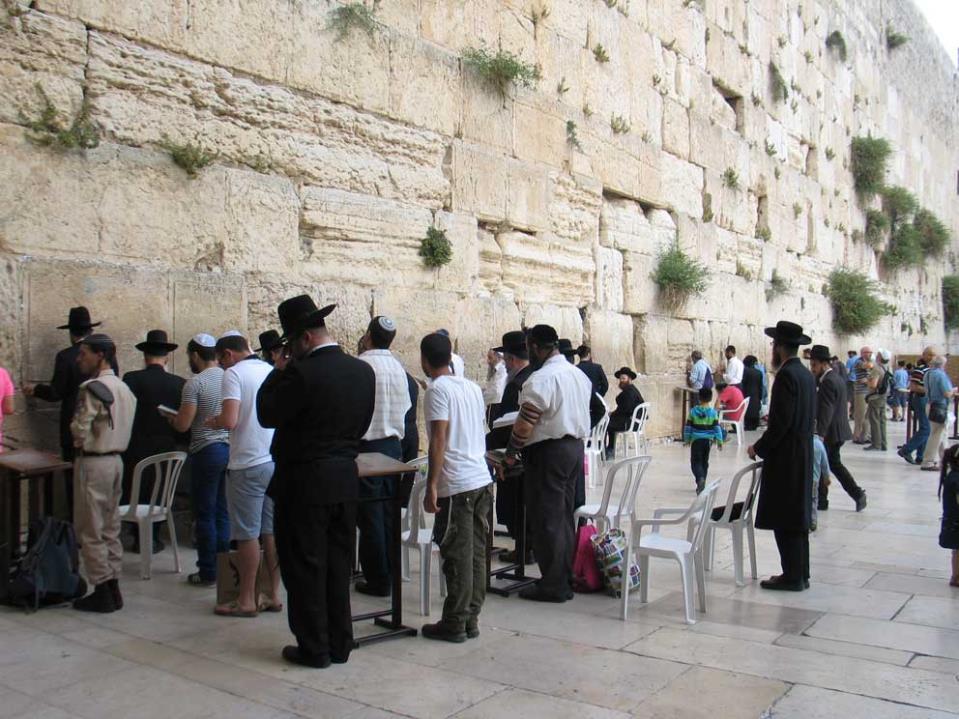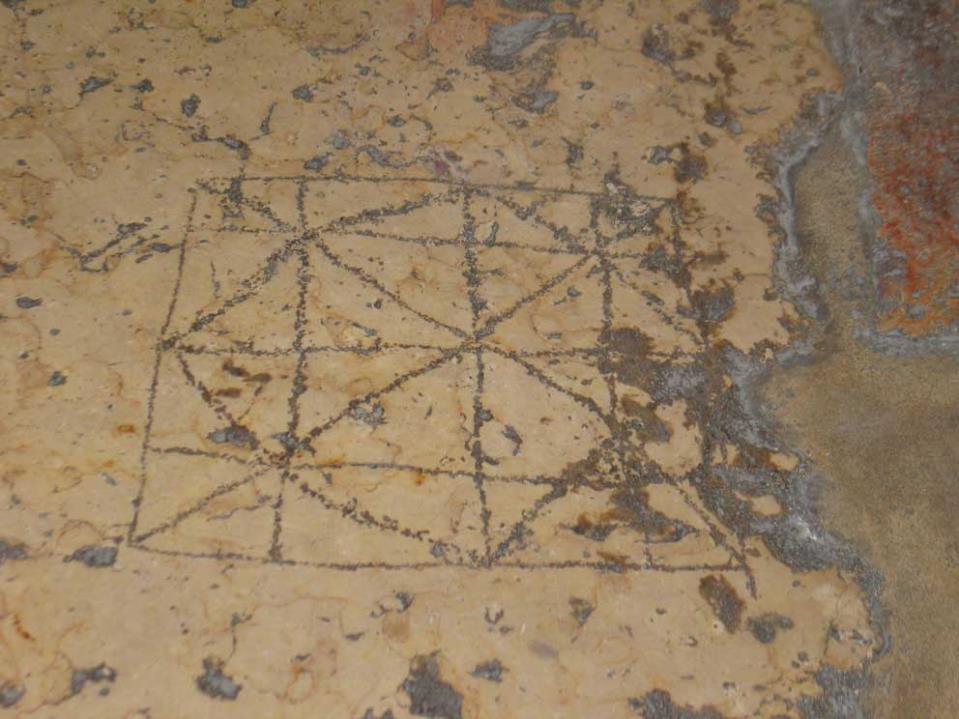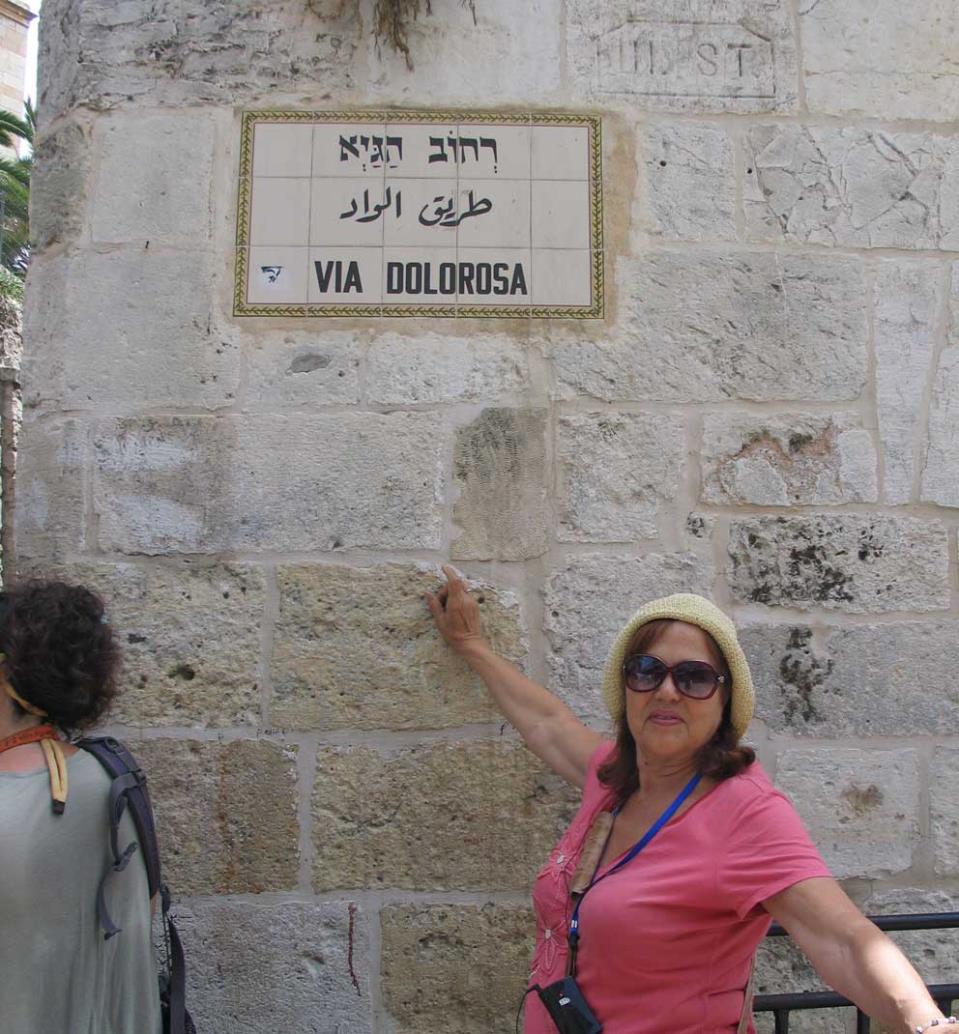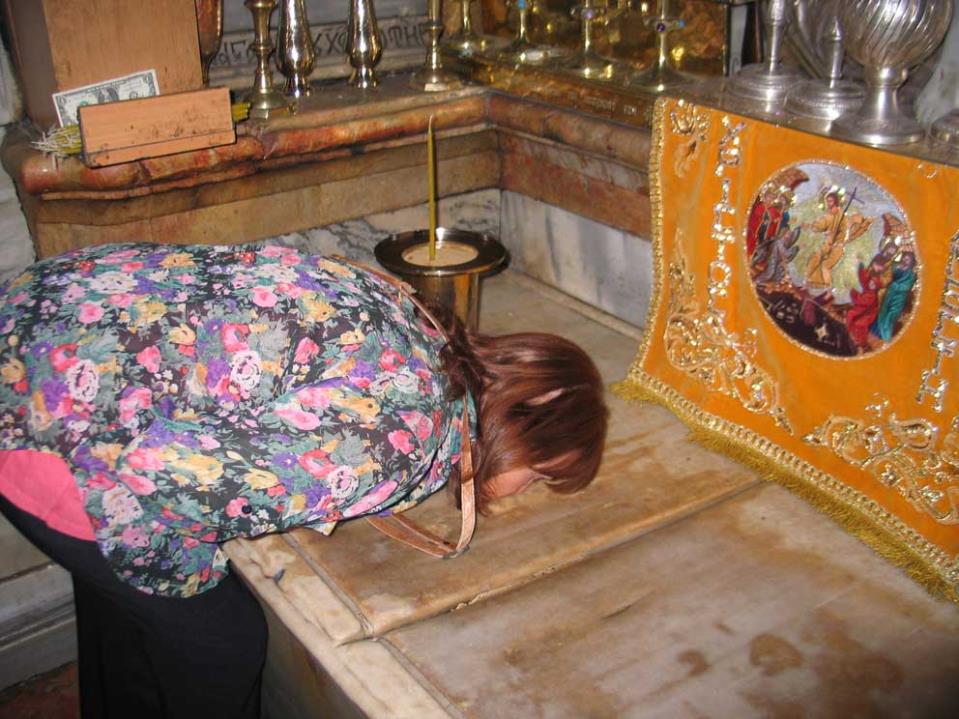A stone's throw away from the Holy Cenacle [from Latin coenaculum - referring to the 'Last Supper House'] on Mount Zion, stands the Saint Francis ad Coenaculum monastery. This is a very important place for the Franciscans of the Holy Land; it is near the spot where the Franciscans established their first monastery about eight centuries ago.

In the chapel of this monastery we heard Mass concelebrated, as usual, by Mgr Joseph Bezzina and Fr Anthony, this time together with two priests from Romania. Behind the altar stands a complex of bronze life-size figures representing Christ standing, and the Apostles some sitting, some standing too, during the Last Supper. It is the work of Antonio Barluzzi who placed his figure as that of Jude, in the group. The Italian artist has also made the stylized life-size statue of Our Lady looking at the Supper scene from a niche, on the right hand side of the altar.
Afterwards we walked to the centre of the old part of the city - the Jewish Quarter - among the high marble columns that are still in place from the time when the whole of the main street had such columns and shops all along, on both sides, as may be seen, and we did observe, in the mosaic map in St George's Church at Madaba.
At the end of this street, we stopped at a place from where, some 10 meters below us, lays the large square with the Western Wall. Here Fr Anthony explained the historical scenario of the Wall and the difference in dress among Jews of one place and another; the reason behind the locks in Jewish men's hair; and the purpose why Jewish women have their hair shaved [as evidence of their submission to men]. He also explained why the wall - in front of which men stood praying or reading the bible on the left hand side, while women stood on the right, with a fence in between - is called the Wailing Wall or Kotel ['the Buraq Wall']. It is a remnant of the ancient wall that surrounded the Jewish Temple's courtyard, and is perhaps the most sacred site recognized by the Jewish faith outside of the Temple Mount itself. Just over half the wall, including its 17 courses located below street level, dates back to 70 A.D. It is called 'wailing' ('crying, weeping') with reference to the practice of Jews weeping at the site over the destruction of the Temples.
It has been a site for Jewish prayer and pilgrimage for centuries.

After the 1948 Arab-Israeli War the Wall came under Jordanian control and Jews were barred from the site for 19 years until Israel captured the Old City in 1967.
Some of us walked further down, passed through the security gate, walked down the steps, and on to the Wall where there were several men praying or reciting selections from the bible, in loud voices, and moving their bodies simultaneously.
I joined the men. Irma walked and prayed in front of the wall on the other side of the dividing fence.
Later, in the evening, we were driven to the Gethsemani Basilica [also the Agony Basilica] and, in the Gethsemani Garden nearby. Among olive trees, at 20.00 we took part in an Ora Santa - a Holy Hour. During the service, members form the groups read excerpts from the Bible [particularly the passages where the Evangelists narrate Christ's agony in the Garden (Luke 22:39-46; Matthew 26:36-46) and sang hymns in the different languages of the three groups taking part.
It is emotional to feel to be praying where Jesus is believed to have experienced agony thinking about the passion and crucifixion he had to pass through.
The adoration came to an end with the singing of the 'Tantum Ergo' in Latin, and Benediction.
Church of the Holy Sepulchre
On Wednesday 7 May, at 5.45 we started walking towards the Basilica of the Tomb of Christ also called the Basilica of the Holy Sepulchre, or the Basilica of the Resurrection by Eastern Christians. It is found within the Christian Quarter of the walled Old City of Jerusalem, a few steps away from the Muristan complex of streets and shops. [Muristan from Persian Bimārestān. The site was the location of the first hospital of the Knights Hospitaller.]

This was perhaps the culmination of our experience in the pilgrimage.
The site is venerated as Golgotha [the Hill of Calvary], where Jesus was crucified, and is said also to contain the place where he was buried; the 'Sepulchre'.
The church has been an important pilgrimage destination since at least the fourth century. Today it also serves as the headquarters of the Greek Orthodox Patriarch of Jerusalem, while control and management of the Basilica is shared among six Religious sects: the Greek Orthodox Church, the Roman Catholic Church, the Armenian Orthodox Church, the Syriac Church, the Egyptian Copts, and the Ethiopian Orthodox Church. [A decree of 1853, from the sultan of the period, set the existing territorial division (reaffirming the provisions of a 1757 decree) among the Ecumenical Christian communities and established a status quo for arrangements to 'remain forever', because of the differences of opinion about the upkeep and even minor changes. (This includes the disagreement on the removal of a cedar wood Immovable Ladder - an exterior ladder under one of the windows which has remained in the same position since 1728.)]
Mgr Bezzina and Fr Chircop concelebrated Holy Mass in a chapel in the Basilica.
Soon after we went to visit the place where the hole in the rock, for the Cross of the Crucifixion is found, covered with a round silver plate, with a hole in the middle, beneath a small niche. Each one of us had the opportunity to kneel down and pray near the 'divine' hole.
Still in the Basilica, the members of the group were lead to the Tomb of Christ which is found in the Aedicule [diminutive of Latin aedes and means a 'small shrine'], with the marble decoration of the Tomb which dates mainly to the 1555 restorations. In the small place around the tomb [in the Aedicule] two masses were said for two different groups.
At 8.00 the Franciscan Fathers gave up the guard to the Armenian Christians [according to the status quo], and our group was admitted into the Holy Place - the tomb where Jesus was laid after his death on the cross.

Even if you do not believe, the blood that runs in you makes you shiver. Living as a Catholic ... you bend down and kiss the marble that covers the ground on which the lifeless body of the Son of God lay for three days ... and hold your breath and weep in silence, with great reverence, with deep respect, in absolute adoration!
I was there.
We participated in the [daily] Procession of the Cross which went round the Aedicule. It was during this event that I observed the iron framework which surrounds the marble walls of this shrine, supporting it from falling down to pieces; an earthquake which took place in 1927 threatened to destroy it.

The 'Via dolorosa'
The last spiritual commitment on our programme was walking along the Via Dolorosa - which incorporates most of the 14 Stations of the Cross.
We started with the Sanctuary of St Anne near the Lions' Gate, and walked on to the church of the Flagellation and the church of Condemnation and Imposition of the Cross in the Muslim Quarter. These were the First and Second Stations.
The imposition of the cross is indicated on the external wall of the sanctuary of the Condemnation.
The latter two churches are annexed to the Franciscan convent, seat of the Studium Biblicum Franciscanum, and stand at the traditional Second Station of the Cross. [Christian tradition places here two moments from the Passion of Jesus: the flagellation and the condemnation to death.
In the floor of the Condemnation church are conserved several Roman pavement stones of the Lithostrotos [Greek λιθόστρωτος 'a paved or mosaic-laid floor'. This is believed to be the place of the trail of Jesus before Crucifixion c. 30/33 A.D.] There are also two beautiful life-size bass-relieves of Christ being condemned by Pontius Pilate, and of St John trying to hide the sight of the suffering Christ from his mother Mary, on his way to Calvary.
On the floor of this church there is the design - made up of squares and triangles, chiseled by game-playing Roman soldiers - similar, perhaps, to the 'game' which could have been played for the robe of Jesus before he was nailed to the cross.

Other stations
We followed the route stopping at several places marked as Stations where Jesus passed through on his way to Golgotha. It was a little difficult to keep recollected in prayer and contemplation; the narrow street is full of bars and shops on both sides and, people and tourists throng the space all along.
However, we managed to pay a visit and stop at most of the other 7 Stations [3 - 9]; the remaining 5 Stations [10 - 14] are found in the Church of the Holy Sepulchre.
Station 3 commemorates where Jesus fell for the first time under the weight of the cross; Station 4 - where Mary watched her son go by carrying the cross; Station 5 - where Simon of Cyrene helped Jesus carry the cross; Station 6 - where St Veronica wiped Jesus' face with her handkerchief and an image of his face remained imprinted on the cloth; Station 7 - where Jesus fell for a second time; Station 8 - marked with a cross and the Greek inscription 'NIKA' on the wall of the Greek Orthodox Monastery of St Charalambos - this is where Jesus consoled the lamenting women of Jerusalem; and Station 9 - where Jesus fell the third time.
Conclussion
Is it true that all the places related to the birth, life, passion, death, and resurrection of Christ in the Holy Land, which we have visited with reverence and devotion, are the real ones mentioned in the Gospels?
In his first lecture about the pilgrimage - in the yard in front of St Joseph's church - Fr Anthony had emphasized that most of the places are 'memorials' [objects that serve as a focus for the memory of something - in the case of the Holy Land, events from the life of Christ]. He had also insisted that tradition played a great part in the establishment of the association of the particular sites with 'events' in the life of Christ. He had, moreover, stated that sometimes archeology provided proof of what had been held as tradition to very probably be 'the real place/s' related with the evangelical narrative.

Whatever the personal inclinations, all along the pilgrimage, the resigned participant is engulfed in seeing, admiring, praying, contemplating, and living a holy journey. The experience is fundamental and memorable. The pilgrimage is a spiritual encounter with what the Christian believes in: the 'precious' land - 'the much-trampled prize for conquering armies' - which has been drenched with the blood of men fighting to own it, because it is 'Holy', because it is the place where the Son of God entered into a relationship with Man.
Yes, it is an extraordinary and unforgettable experience, so relaxing for our ever Truth searching Soul.
All photos reproduced with this article were taken by the author.
© Joe Zammit Ciantar
[email protected]